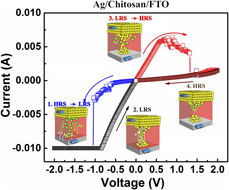Crossref Citations
This article has been cited by the following publications. This list is generated based on data provided by
Crossref.
My Tran, Kim
Phuc Do, Dinh
Nam Vu, Hoang
Nguyen, Toan T
Thang Phan, Bach
Hanh Ta Thi, Kieu
and
Ngoc Pham, Kim
2020.
Experimental combined theoretical study on chemical interactions of graphene oxide with chitosan and its resistive-switching effect.
Materials Science and Engineering: B,
Vol. 262,
Issue. ,
p.
114788.
Khot, Atul C.
Dongale, Tukaram D.
Park, Ju Hyun
Kesavan, Arul Varman
and
Kim, Tae Geun
2021.
Ti3C2-Based MXene Oxide Nanosheets for Resistive Memory and Synaptic Learning Applications.
ACS Applied Materials & Interfaces,
Vol. 13,
Issue. 4,
p.
5216.
Min, Shin-Yi
and
Cho, Won-Ju
2021.
Memristive Switching Characteristics in Biomaterial Chitosan-Based Solid Polymer Electrolyte for Artificial Synapse.
International Journal of Molecular Sciences,
Vol. 22,
Issue. 2,
p.
773.
Rehman, Muhammad Muqeet
ur Rehman, Hafiz Mohammad Mutee
Kim, Woo Young
Sherazi, Syed Sibtul Hassan
Rao, Muhammad Wajdan
Khan, Maryam
and
Muhammad, Zubair
2021.
Biomaterial-Based Nonvolatile Resistive Memory Devices toward Ecofriendliness and Biocompatibility.
ACS Applied Electronic Materials,
Vol. 3,
Issue. 7,
p.
2832.
Xing, Yuan
Sueoka, Brandon
Cheong, Kuan Yew
and
Zhao, Feng
2021.
Nonvolatile resistive switching memory based on monosaccharide fructose film.
Applied Physics Letters,
Vol. 119,
Issue. 16,
Min, Jin-Gi
and
Cho, Won-Ju
2021.
Chitosan-Based Flexible Memristors with Embedded Carbon Nanotubes for Neuromorphic Electronics.
Micromachines,
Vol. 12,
Issue. 10,
p.
1259.
Cheong, Kuan Yew
Tayeb, Ilias Ait
Zhao, Feng
and
Abdullah, Jafri Malin
2021.
Review on resistive switching mechanisms of bio-organic thin film for non-volatile memory application.
Nanotechnology Reviews,
Vol. 10,
Issue. 1,
p.
680.
Kiran, M Raveendra
Yadav, Yogesh
and
Singh, Samarendra P
2022.
Chitosan based memory devices: filamentary versus interfacial resistive switching.
Journal of Physics D: Applied Physics,
Vol. 55,
Issue. 5,
p.
055302.
Jetty, Prabana
Sahu, Dwipak Prasad
and
Jammalamadaka, Suryanarayana
2022.
Analog Resistive Switching in Reduced Graphene Oxide and Chitosan‐Based Bio‐Resistive Random Access Memory Device for Neuromorphic Computing Applications.
physica status solidi (RRL) – Rapid Research Letters,
Vol. 16,
Issue. 2,
Patel, Monika
Hemanth, Neelgund Ramesh
Gosai, Jeny
Mohili, Ranjit
Solanki, Ankur
Roy, Mohendra
Fang, Baizeng
and
Chaudhari, Nitin K.
2022.
MXenes: promising 2D memristor materials for neuromorphic computing components.
Trends in Chemistry,
Vol. 4,
Issue. 9,
p.
835.
Sharma, Neetu
Singh, Karamvir
Tripathi, C. C.
and
Bera, M. K.
2023.
Biomemristor with Phototunable Resistive Switching Characteristics of a Neem (Azadirachta indica)-Carbon Quantum Dots Composite Thin Film.
Journal of Electronic Materials,
Vol. 52,
Issue. 5,
p.
3264.
Raeis-Hosseini, Niloufar
Georgiadou, Dimitra G.
and
Papavassiliou, Christos
2023.
High On/Off Ratio Carbon Quantum Dot–Chitosan Biomemristors with Coplanar Nanogap Electrodes.
ACS Applied Electronic Materials,
Vol. 5,
Issue. 1,
p.
138.
Awais, Muhammad
Zhao, Feng
and
Cheong, Kuan Yew
2023.
Bio-Organic Based Resistive Switching Random-Access Memory.
Solid State Phenomena,
Vol. 352,
Issue. ,
p.
85.
Sharma, Neetu
Singh, Karamvir
Tripathi, C. C.
and
Bera, M. K.
2023.
Biomemristor based on a natural medicinal plant (Tinospora cordifolia) and their phototunable resistive switching properties integrated with carbon quantum dots.
Applied Physics A,
Vol. 129,
Issue. 1,
Jetty, Prabana
and
Jammalamadaka, Suryanarayana
2023.
Temperature Evolution of Charge Transport in Chitosan Based Bio‐Resistive Random‐Access Memory Device.
physica status solidi (a),
Vol. 220,
Issue. 9,
Ozel, Kenan
and
Kocak, Yavuz
2023.
Bio-inspired diodes made of chitosan/p-Si sandwich structure.
Sensors and Actuators A: Physical,
Vol. 360,
Issue. ,
p.
114521.
Sharma, Neetu
Singh, Karamvir
Tripathi, C. C.
and
Bera, M. K.
2023.
Resistive switching in neem (Azadirachta indica) thin film for a cost-effective and washable biomemristor.
Journal of Materials Science: Materials in Electronics,
Vol. 34,
Issue. 1,
Kumar Yadav, Ankit
Prakash, Chandra
Pandey, Akhilesh
and
Dixit, Ambesh
2023.
Impact of Top Electrodes (Cu, Ag, and Al) on Resistive Switching behaviour of Cu‐rich Cu2ZnSnS4(CZTS) Ideal Kesterite.
ChemPhysChem,
Vol. 24,
Issue. 21,
Saha, Mainak
Dey, Subham
Nawaz, Sk Masum
and
Mallik, Abhijit
2023.
Environment-friendly resistive memory based on natural casein: Role of electrode and bio-material concentration.
Organic Electronics,
Vol. 121,
Issue. ,
p.
106869.
El-Newehy, Mohamed H.
El-Mahalawy, Ahmed M.
Thamer, Badr M.
and
Moydeen Abdul Hameed, Meera
2023.
Fabrication and Characterization of Eco-Friendly Thin Films as Potential Optical Absorbers for Efficient Multi-Functional Opto-(Electronic) and Solar Cell Applications.
Materials,
Vol. 16,
Issue. 9,
p.
3475.



